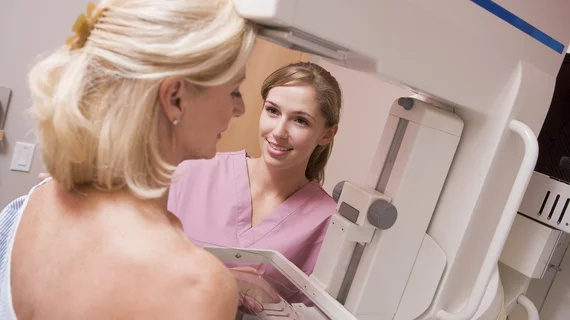Pandemic’s hardest hit breast-care segment: Screening mammography
COVID-19 set back screening mammography further than any other category of breast care, dropping schedule adherence during infection peaks to 36% of pre-pandemic rates.
By contrast, diagnostic mammography chugged along at 58% of normal volumes during COVID surges while biopsies did 47% and cancer diagnoses 49%.
All of those also saw significantly greater activity than screenings during COVID valleys. While screenings rebounded to a robust 86%, diagnostic mammography hit 98% and both biopsies and cancer diagnoses came back to around 92%.
The findings are from an analysis of more than 7.2 million patient records in the American College of Radiology’s National Mammography Database.
The study report, published online June 8 in JACR, was lead-authored by Lars Grimm, MD, MHS, of Duke University and senior-authored by Margarita Zuley, MD, of the University of Pittsburgh [1].
Also of note among the researchers’ key findings, the negative COVID effect on breast care was disproportionately pronounced in older women, Asian women, facilities in the Northeast and facilities affiliated with academic medical centers.
In addition, the authors report, cancer diagnoses still have yet to fully rebound, “emphasizing the need to increase outreach efforts directed at specific patient population and facility types.”
For the study, the researchers analyzed facility-level and overall data across three pertinent time windows: pre-COVID (March 1, 2019, to May 31, 2019), peak COVID (March 1, 2020, to May 31, 2020) and COVID recovery (March 1, 2021, to May 31, 2021).
Grimm and co-authors state their analysis offers the largest and broadest look at the pandemic’s impact on U.S. breast cancer screening outcomes both during the peak of the pandemic and in the subsequent (rebound) year.
They point out the falloff in screening mammography tracked with federal guidelines to postpone screening services, adding that similar failures to return to regular screening intervals have been recorded in colon and cervical cancer screening.
Meanwhile the impact of the pandemic on facility demographics, Grimm and co-authors write, “likely reflects differences in the temporal and geographic distribution of disease.”
The Grimm study arrives a few days after the American Cancer Society published research showing U.S. breast and cervical cancer screenings fell by 2.13 million (6%) and 4.47 million (11%) respectively in 2020 compared to 2018 [2].
More from the Grimm et al. discussion:
If volumes do not normalize, screening mammography will remain underused among asymptomatic women. Strategies to facilitate safe breast imaging have been developed, but radiologists will need to develop outreach efforts, especially at the local level, directed toward patients and ordering providers on the importance of screening mammography in order to improve utilization rates.”
JACR has posted the study in full for free.
More Coverage of Screening Mammography:
‘You Only Look Once’ helps detect, classify lesions on deceptively normal screening mammograms
Mammography AI intercepts density overestimations
Screening breast MRI results in more downstream healthcare costs than mammography alone
Deep learning expedites normal findings on ultrafast breast screenings
Abbreviated breast MRI deemed an attractive screening option—sometimes
'Surprising' decline in annual screening among breast cancer survivors has experts concerned
References:
- Lars Grimm, Margarita Zuley, et al., “Impact of the COVID-19 Pandemic on Breast Imaging: An Analysis of the National Mammography Database.” Journal of the American College of Radiology, June 8, 2022. DOI: https://doi.org/10.1016/j.jacr.2022.04.008
- Stacey Fedewa, Ahmedin Jemal, et al., “Changes in Cancer Screening in the US During the COVID-19 Pandemic.” JAMA Network Open, June 3, 2022. https://jamanetwork.com/journals/jamanetworkopen/fullarticle/2792956

